了解新零售并掌握新零售环境下的市场营销趋势【携程氢气球】
Understanding new retail and knowing marketing
trends in this new retail environment
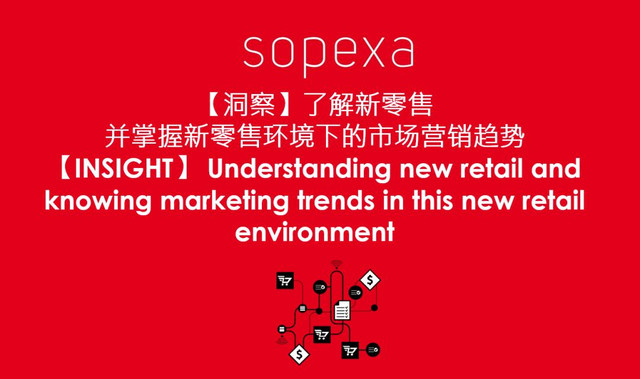
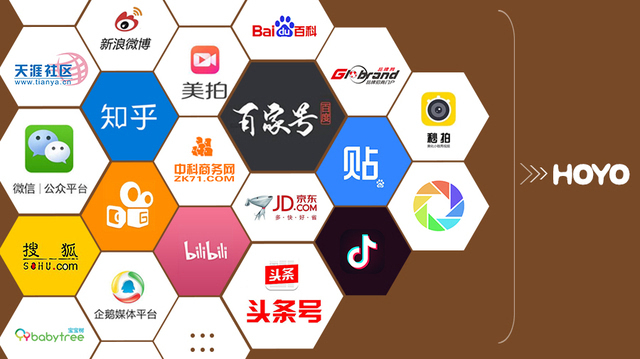
随着新零售的出现新零售营销,中国的零售业进入了一个新节点。 2017年,各行各业的大佬纷纷入场布局新零售,阿里巴巴成为百盛和联华超市的股东,京东宣布将开百万家线下商店, 零售业变革加速。
China’s retail industry reached an inflection point with the advent of New Retail: Alibaba is a good example; It became the stakeholder of Parkson Group, Lianhua Supermarket, while JD.com announced that they would open 1-million offline shops!
The revolution of retail-scape is now.
什么是新零售? What is New Retail?
新零售的概念是被马云提出,是指一种 “以消费者体验为中心,以数据驱动的泛零售形态”,是一条整合了线上,线下,物流和大数据的价值链。
The concept of New Retail was raised by Jack Ma, which refers to generic retail that is data driven and centered on consumer experiences. It integrates online, offline, logistics and data across a single value chain.
具体来说新零售是以消费者为中心,通过数据串联各个消费场景,利用数字化技术实现实体与虚拟的全面融合,提供给消费者覆盖全渠道的无缝消费体验。 这种新形式让线上线下成为相互的补充,并以物流为连接点,实现线上线下双向流动。新零售的最终目的是从数据运用的角度去提升线下零售的效率,把合适的东西带给需要的人
Concretely speaking, New Retail is to meet consumers’ needs by using big data and digital technology to achieve the full integration of all channels (virtual and real ) in order to redefine the chain of “consumers—products—markets” as well as to deliver consumers a seamless and consistent shopping journey.It is a new mode in which online and offline shopping become each other’s complementary channels with logistics as the link to achieve a two-way closed-loop flow. The ultimate goal of new retail is to improve the efficiency of offline retailing by data utilization, and better user experience, bringing the right things to the people who need them.
为什么现在要做新零售?
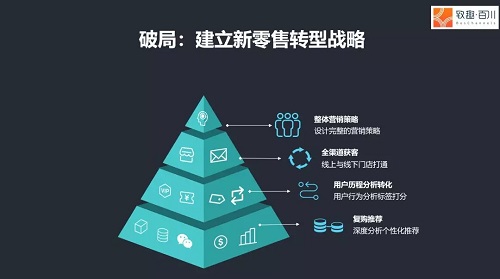
Why New Retail now?
消费升级Consumption upgrade
根据麦肯锡的调查,在接下来的15年内,非必需消费品和半必需品在中国的消费结构中的比例正在逐渐增加。
As per McKinsey, inthe next 15years, the consumption structure in China is gradually shifting towards higherpercentage in consumer discretionary and semi-necessities.
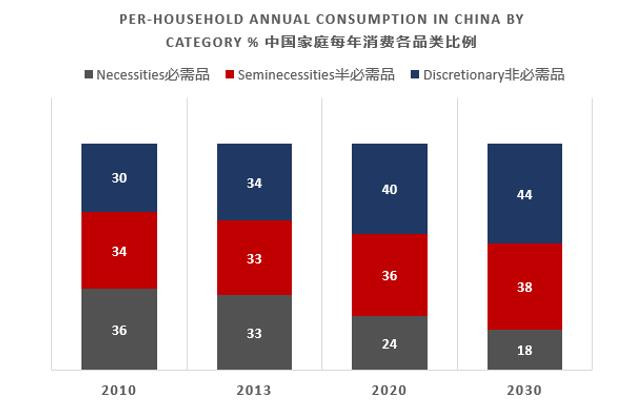
Source: McKinsey, AliResearch
网上红利不在,实体店增长乏力
Slowgrowth of online shopping; Softness of brick-and-mortar retail
从2016开始,互联网销售企业明显感觉到过去躺着也能成长的线上市场红利结束了,线上流量越来越贵,互联网将进入精耕细作的下半场。且吸引新用户的成本变得极高,大大影响到了互联网销售企业的利润。而线下的零售日子也很不好过, 据调查,比较2015年的表现,在2016年,62%的传统零售业都经历了衰退。
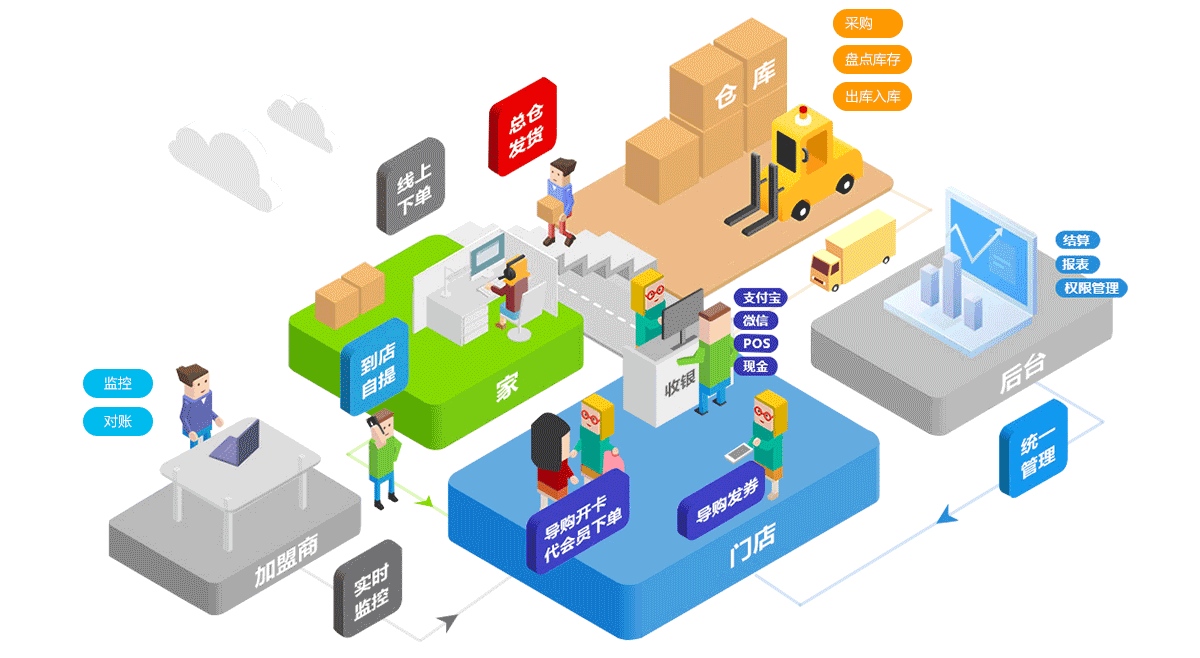
Starting from 2016,internet sales companies clearly have difficulties to grow on the onlinemarket, online traffic becoming more and more expensive, and the cost ofattracting new users increasing rapidly, which affects theirs profits.
The offlineretailers’ days are also tough, according to a survey conducted by Ebrun:62% of thetraditional department stores in China incurred performance decline in 2016 vs.2015.
在购物路径变得难以捉摸的新零售环境下市场营销趋势?
Marketing trends in this new retail environment?
网络购物者在电商发展早期的购物路径非常简单,他们在网上搜索产品,比较价格然后网上下单,最后留下评价。但在今天的新零售环境下,影响消费者的信息和营销渠道变得越来越多,新一代的消费者环境将会变得更加复杂,多样和碎片化。
Online consumers’ shopping flow was quite simple in the early days of e-commerce: search online first, compare products and price, place order online, and at last leave comments and feedback.
However, in today’s ‘New Retail’ environment, people can see that the trends affected by marketing, information sources, and channels, are all rapidly increasing. The new world generation of online consumers, will be more complex, fragmented and varied.

腾讯和尼尔森根据2017年消费数据新零售营销,发布了在新零售大环境下最新的五大营销趋势
According to 2017 Chinese consumption data released by Tencent and Nielsen, five marketing tendencies in new retail environment arise.
趋势一:渠道优势边界模糊,品牌形象需凸显
Tendency 1: Boundariesis becoming blurrier between different channels, retailers need to builddifferentiated Brand identity.
在全球消费升级的趋势下,中国消费者呈现高端化的趋势,越来越多的消费者易被品牌所驱动,差异化品牌形象对于零售购物的影响日趋明显。然而中国消费者很难区分同类零售商直接的品牌差别, 即便本土零售商认知率较高,但缺乏品牌差异化,零售商开始根据分析目标消费者的诉求,通过消费者关注且为自身优势的宣传点切入进行品牌形象区隔的打造。
Under the trend of consumption upgrade, Chinese consumers are looking for products that are more sophisticated, while more and more consumers are brand-driven. Building a brand identity is becoming one of most crucial factors to maintain market competition for retailers.
However, it is difficult for Chinese consumers to tell the difference from one retailer to another nowadays even though they have high brand awareness. Therefore, retailers need to build a differentiated brand image by communicating their own special strengths and work around the key concerns of their target customers
趋势二:广告向精准化,场景化模式转型,会员运营成为精准营销重要手段
Tendency 2: Move to a model of Precision Marketing and Scene Marketing;Members targeted operations become a necessary mean for Precision Marketing
传统广告无法达到精准化,场景化的效果, 因为消费者线下购物的目的不同,消费者画像和场景不同,对于促销内容的爱好也明显不同。消费者画像能让零售商更加聪明的推送个人化的信息给消费者。此外,会员数字化管理是实现精准营销的有效手段,电子会员让零售商了解到其需求,提供他们感兴趣的会员福利,提高客户的品牌忠诚度。
Traditional advertising cannot be accurate since consumer’s preference for marketing content is different because of different shopping purposes, profile, and scenarios. Creating a profile for each client would enhance targeting and personalization, more accurately push content and experiences to him/her.
趋势三:广告创意和投放形式多样化,增强互动性
Tendency 3: Advertising is becoming more dynamic and interactive

读者福利:免费提供私域运营诊断方案(每天随机10个名额)加微信: 57807073 (长安复制) 马上咨询 !版权声明:本文内容由互联网用户自发贡献,该文观点及内容相关仅代表作者本人。本站仅提供信息存储空间服务,不拥有所有权,不承担相关法律责任。如发现本站有涉嫌侵权/违法违规的内容请联系QQ:15101117立即清除!

